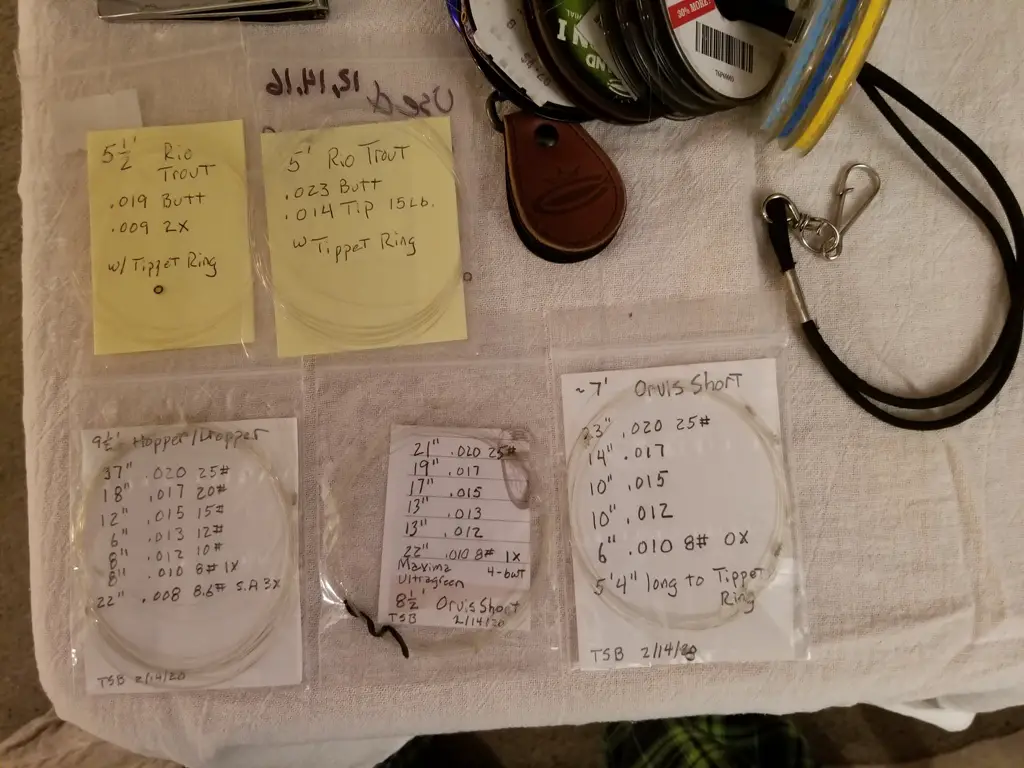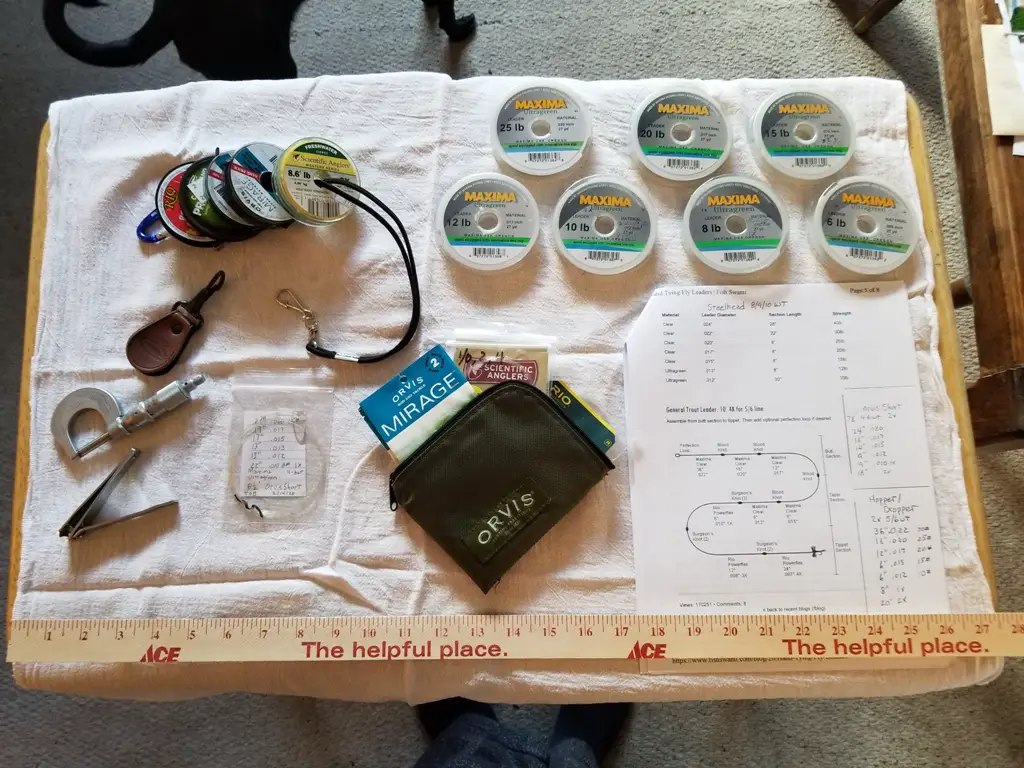Search
Latest Articles
Fly Casting and Leader Tips
by Thomas Butler, March 07, 2020
We headed down to the river a few days later and I gave him a big size 2 steelhead fly he liked. He already had a couple wind knots in the leader but I figured the fly wouldn’t last long anyway, so he tied it on. He had some casting problems, whipping the rod too much without pausing, and dropping the tip below 2:00 on the backcast putting his fly in the bushes. The biggest problem was his leader falling in a heap at the end of the fly line instead of straightening out. Even when he stopped his rod at 10:00 this was happening. After he lost that big weighted fly I gave him a much smaller bugger. Now when he did things right the leader straightened out.
I get tailing loops and my fly tangles in the fly line to leader connection just as it gets to the water. I rotate my shoulder and throw forward with my arm for extra power on the final presentation; a bad habit from swinging bait rigs I can’t seem to break, especially when I get tired. I’m just trying to cast too far. When I do it right though, I can still have this problem if my gear is not set up correctly.
Often times when having casting presentation problems it’s not actually the casting, it may be the leader that is creating or compounding the problem. Using a good leader will make it easier to see and correct some of the other problems as well.
Several of our problems the first day with the 8wt were because of that leader. Most store bought tapered leaders come with a choice of length and X size, or breaking strength. The one that came with this rod was 9’ long in 4X, a leader more suited to a 5wt rod and size 12 fly. I find that with most store bought leaders the butt section is too limp and short, and the tippet portion too long. The butt diameter of each leader out of a two pack may be different also. Once we had lost a lot of the tippet and got to a fatter part of the leader with an appropriate sized fly the system worked better. It was still hinging at the loop attachment to the end of the fly line. The butt of the leader was too small for the 8wt line, again for more like a 5wt. Most store bought leaders are made for a 6wt rod.
If we had had the appropriate leader the first outing may have been more successful. Back in the day I used to tie my own leaders. I seem to get better presentations using a hand tied leader. I still have many store bought tapered leaders, and they have their good points. They don’t seem to pick up as many weeds when retrieving through cover. They are convenient, and if I get a good price I don’t mind loosing part to the bushes as much as one I worked hard on. But, I like to fish droppers, and I find store bought tapered leaders miserable for this.
Here’s how I tie my leaders. I am currently using Maxim Ultragreen, as it’s what I have at home now, and they perform well. I like to use Chameleon for the big butt sections, as it seems a little stiffer, and will pick some more up next time I go to the store. I raided the salmon, steelhead and trout boxes and found I had all the sizes I needed already. Do not skip a size if you want it to work right. Then practice knots. Practice a perfection loop with the biggest stuff until you have it down, don’t use a surgeons loop, they almost always put a 30 degree bend at your knot. Practice your blood knots also! For the biggest stuff I can usually only get 3 turns and a good knot. Adding one more turn on the smaller side is beneficial. At around 15lb I’m using 3 and 4 turns, and 4 turns with 5 on the small side down around 8 or 6 lb line. I leave 2 ½” tags, wind the large around the small and make an X, then wind and poke through the small one on the other side. I then press the unsnugged, loose knot X against my tongue with my index finger. Then holding against the roof of my mouth while slobbering, slowly pull each main line tight. You may alternate squeezing your fingernails against the knot and pulling the main line until snug. If done correctly you can trim flush to the knot and it will hold without slipping. Don’t worry if one section is a little short because you tied twice.
To construct the leader I like to start at the big end by tying a small perfection loop in the butt section while still on the spool. This section should be 2/3 the diameter of your fly line. I haven’t measured mine. I just use published leader formulas for line size and desired tippet from the internet. I like the Fish Swami’s blog post from 3/24/08 about hand tied leaders and the Mad River Outfitter’s site for ideas. Some of my old books also have formulas too, and they are way shorter than we tend to fish today. Bergman’s Trout lists gut and some nylon, so it’s too old. Be aware that you can really go down the rabbit hole with this, different makes of line can even vary as well. My old 6wt Cortland 444 is way thicker than the 6wt Sylk, and a WF4 is thicker than DT4. I’m not a good enough caster for this to matter yet, at least that I can tell.
Once I have a good perfection knot I’ll measure the first butt section and add 2 ½” for the blood knot (I know from my practice what I need). I’ll measure the next section, plus 5” extra and tie it in. I test, trim, and test each knot as I go for each section in succession. You can use a double surgeons knot for the final tippet if you like, especially when out fishing. Pull straight to tighten for a straight knot, if you lever your fingers you will get an angled knot. I don’t end up exact and they still work better than store bought. I then put all the info on a card and put it coiled in a bag with a date. This makes it easy to size repair sections and know when two years has gone by to not trust it. It takes me about 30 minutes to make each one.
I fight 9’ leaders and tangles so I try to shoot for 7 1/2 to 8’. This way it also stays out of my tip top when stalking except on the shortest rods. If I need longer I’ll add a smaller tippet to one. Many of these are tied with a 6” tag on the lower blood knot or two for droppers, being set at 90 degrees they don’t tangle too often. Another dropper option is to tie a loop in one end of a short leader piece, then loop it over a knot to keep it in place.
Many things affect matching fly size to tippet size, weighting and bulk of fly among them. Generally divide fly size by 3 to get the X size tippet, and go heavier if needed to control the fly. A tangled fly won’t catch fish, and surprisingly few will actually be spooked by a leader bigger than you may be tempted to use otherwise.
I know many of us haven’t picked up a fly rod in a while. Working with my son reminded me of many simple issues that are easy to correct and make the fishing much more enjoyable. Having some of this sorted out should help when we get a fly rod into the grand-kids hands next summer too.
It’s not always easy to figure out what may be wrong by yourself, so have a fishing partner observe your casting while keeping this article in mind. Also, watch some videos on-line before you go out, it will get you excited and have you focused on what you should be doing. With a bit of practice and well set up gear you’ll be catching fish instead of untangling line.


